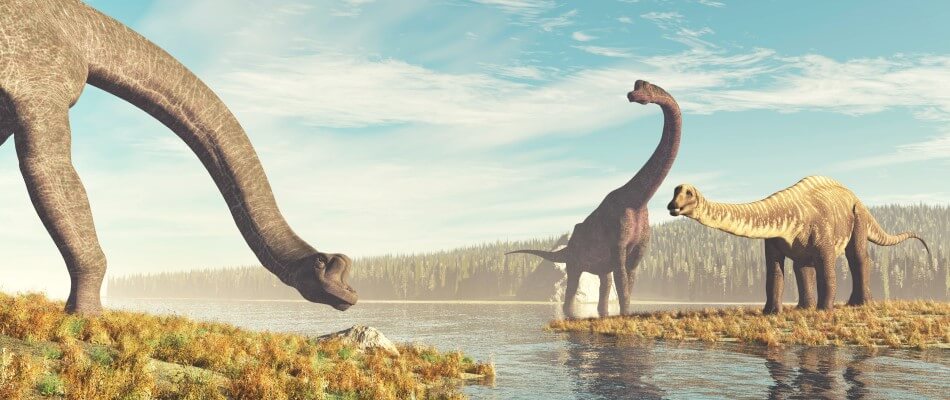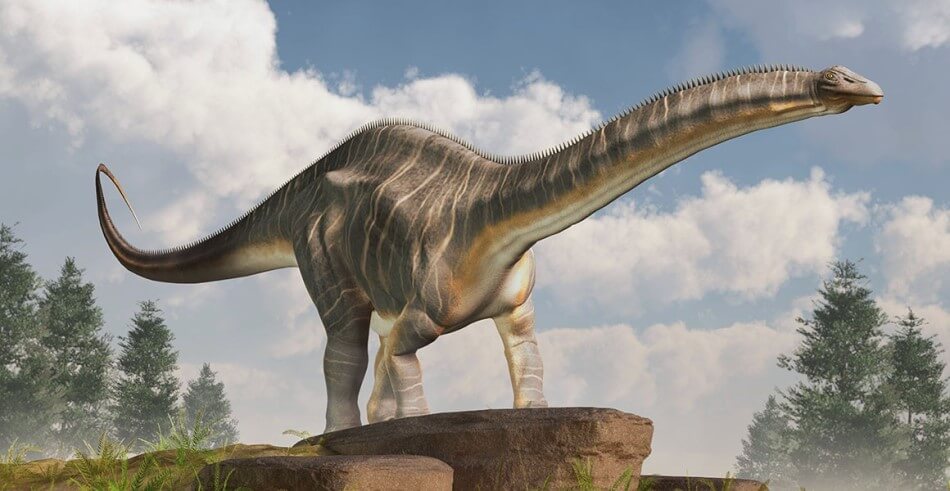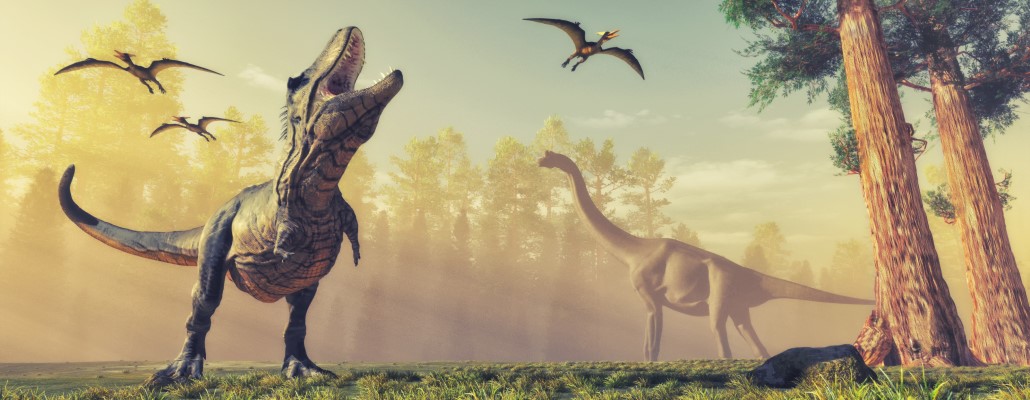There are several well known dinosaurs beginning the letter B: the beloved Brachiosaurus from films such as ‘Land Before Time’, the small and mischievous Bambiraptor, and the universally recognised Brontosaurus.
However, while there is a section below on the Brontosaurus, it’s actually now known as the Apatosaurus due to confusion around fossil findings…! You can find all the dinosaurs beginning with the letter A here.
While not a complete list, this posts includes a good chunk of known dinosaur species beginning with the letter B, along with some additional information around their characteristics, habitat, diet and timelines.
Explore Dinosaur Species
Explore the Dinosaur A to Z
- Dinosaurs beginning with B
Bactrosaurus
Bactrosaurus, meaning Greek for “staff lizard”, was pronounced BACK-tro-SORE-us. It was a herbivore that was found in the Woodlands of Asia during the Late Cretaceous period, around 95-85 million years ago. It was 20 feet long and weighed around two tons, and it’s notable characteristics were: Thick trunk; club-shaped spines on the backbone..
Bagaceratops
Bagaceratops, meaning Mongolian/Greek for “small horned face”, was pronounced BAG-ah-SEH-rah-tops. It was a herbivore that was found in the Plains of central Asia during the Late Cretaceous period, around 80 million years ago. It was 3 feet long and weighed around 50 pounds, and it’s notable characteristics were: Small size; beaked, horned snout.
Balaur
Balaur, meaning Romanian for “dragon”, was pronounced BAH-lore. It was a carnivore that was found in the Woodlands of eastern Europe during the Late Cretaceous period, around 70-65 million years ago. It was three feet long and weighed around 25 pounds, and it’s notable characteristics were: Muscular build; double claws on hind feet.
Bambiraptor

Bambiraptor, meaning “Bambi thief,” after the Disney cartoon character, was pronounced BAM-bee-rap-tore. It was a carnivore that was found in the Plains of western North America during the Late Cretaceous period, around 75 million years ago. It was four feet long and weighed around 10 pounds, and it’s notable characteristics were: Small size; bipedal posture; feathers; relatively large brain; single, curved claws on hind feet.
Barapasaurus
Barapasaurus, meaning Greek for “big-legged lizard”, was pronounced bah-RAP-oh-SORE-us. It was a herbivore that was found in the Plains of southern Asia during the Early-middle Jurassic period, around 190-175 million years ago. It was 60 feet long and weighed around 20 tons, and it’s notable characteristics were: Long legs and neck; short, deep head.
Barosaurus
Barosaurus, meaning Greek for “heavy lizard”, was pronounced BAH-roe-SORE-us. It was a herbivore that was found in the Plains of North America during the Late Jurassic period, around 155-145 million years ago. It was 80 feet long and weighed around 20 tons, and it’s notable characteristics were: Extremely long neck and tail; tiny head; relatively slender build.
Barsboldia
Barsboldia, meaning after paleontologist Rinchen Barsbold, was pronounced barz-BOLD-ee-ah. It was a herbivore that was found in the Plains of central Asia during the Late Cretaceous period, around 70 million years ago. It was Undisclosed and weighed around N//A, and it’s notable characteristics were: Crest along back; long, thick tail.
Batyrosaurus
Batyrosaurus, meaning Greek for “Batyr lizard”, was pronounced bah-TIE-roe-SORE-us. It was a herbivore that was found in the Plains of central Asia during the Late Cretaceous period, around 85-75 million years ago. It was 20 feet long and weighed around 1-2 tons, and it’s notable characteristics were: Large size; narrow snout; claws on thumbs.
Beipiaosaurus
Beipiaosaurus, meaning Greek for “Beipiao lizard”, was pronounced BAY-pee-ow-SORE-us. It was a herbivore that was found in the Woodlands of Asia during the Early Cretaceous period, around 125 million years ago. It was seven feet long and weighed around 75 pounds, and it’s notable characteristics were: Feathers; long claws on front hands; sauropod-like feet.
Bellusaurus
Bellusaurus, meaning Greek for “beautiful lizard”, was pronounced BELL-oo-SORE-us. It was a herbivore that was found in the Woodlands of Asia during the Late Jurassic period, around 160-155 million years ago. It was 13 feet long and weighed around 1,000 pounds, and it’s notable characteristics were: Long neck and tail; short spines on back.
Bonitasaura
Bonitasaura, meaning Greek for “La Bonita lizard”, was pronounced bo-NEAT-ah-SORE-ah. It was a herbivore that was found in the Woodlands of South America during the Late Cretaceous period, around 70-65 million years ago. It was 30 feet long and weighed around 10 tons, and it’s notable characteristics were: Square jaw with blade-shaped teeth.
Borogovia
Borogovia, meaning after the borogoves in Lewis Carroll’s poem Jabberwocky, was pronounced BORE-oh-GO-vee-ah. It was a carnivore that was found in the Plains of central Asia during the Late Cretaceous period, around 70-65 million years ago. It was six feet long and weighed around 25 pounds, and it’s notable characteristics were: Small size; bipedal posture; probably feathers.
Bothriospondylus
Bothriospondylus, meaning Greek for “excavated vertebra”, was pronounced BOTH-ree-oh-SPON-dill-us. It was a herbivore that was found in the Woodlands of western Europe during the Late Jurassic period, around 155-150 million years ago. It was 50-60 feet long and weighed around 15-25 tons, and it’s notable characteristics were: Large size; long neck and tail.
Brachyceratops
Brachyceratops, meaning Greek for “short-horned face”, was pronounced BRACK-ee-SEH-rah-tops. It was a herbivore that was found in the Woodlands of North America during the Late Cretaceous period, around 75 million years ago. It was 20 feet long and weighed around one ton, and it’s notable characteristics were: Frilled skull with short horns.
Brachiosaurus

Brachyceratops, meaning Greek for “arm lizard”, was pronounced brae-kee-uh-saw-ruhs. It was a herbivore that was found in the woodlands of North America during the late Jurassic to the Early Cretaceous period, around 161.2 million years ago – 145 million years ago. It was between 59 and 72 feet long and weighed up to 28 tons, and it’s notable characteristics were: a very long neck and relatively short tails.
Brachytrachelopan
Brachytrachelopan, meaning Greek for “short-necked shepherd”, was pronounced BRACK-ee-track-ELL-oh-pan. It was a herbivore that was found in the Plains of South America during the Late Jurassic period, around 150 million years ago. It was 30 feet long and weighed around 5-10 tons, and it’s notable characteristics were: Unusually short neck; long tail.
Bravoceratops
Bravoceratops, meaning Greek for “wild horned face”, was pronounced BRAH-voe-SEH-rah-tops. It was a herbivore that was found in the Woodlands of southern North America during the Late Cretaceous period, around 70 million years ago. It was Undisclosed and weighed around N//A, and it’s notable characteristics were: Narrow snout; horns above eyes; large frill.
Brontomerus
Brontomerus, meaning Greek for “thunder thighs”, was pronounced BRON-toe-MARE-us. It was a herbivore that was found in the Woodlands of North America during the Early Cretaceous period, around 110 million years ago. It was 40 feet long and weighed around 6 tons, and it’s notable characteristics were: Moderate size; unusually thick hip bones.
Brontosaurus

The Brontosaurus became known as “Apatosaurus”, due to debates around fossil findings. You can find it in our list of dinosaurs beginning with A. However, in the last several years it has been decided that the Brontosaurus and the Apatosarus were indeed different species, and not the same.
Brontosaurus, meaning “thunder lizard”, was pronounced bron-tuh-saw-ruhs. It was a herbivore that was found in Western North America during the Late Jurassic period, around 156-145 million years ago. It was up to 68 feet long and weighed up to 45 tons , and its notable characteristics were: a very long neck and tail, with four massive pillar-like legs.
Bruhathkayosaurus
Bruhathkayosaurus, meaning Greek for “huge-bodied lizard”, was pronounced broo-HATH-kay-oh-SORE-us. It was a herbivore that was found in the Woodlands of India during the Late Cretaceous period, around 70 million years ago. It was Up to 150 feet long and weighed around 200 tons, if it really existed, and it’s notable characteristics were: Enormous size; long neck and tail.
Buitreraptor
Buitreraptor, meaning combination Spanish/Greek for “vulture thief”, was pronounced BWEE-tray-rap-tore. It was a carnivore that was found in the Plains of South America during the Late Cretaceous period, around 90 million years ago. It was four feet long and weighed around 25 pounds, and it’s notable characteristics were: Long, narrow snout; smooth teeth; probably feathers.
Byronosaurus
Byronosaurus, meaning Greek for “Byron’s lizard”, was pronounced BUY-ron-oh-SORE-us. It was a carnivore that was found in the Deserts of central Asia during the Late Cretaceous period, around 85-80 million years ago. It was 5-6 feet long and weighed around 10-20 pounds, and it’s notable characteristics were: Moderate size; long snout with needle-like teeth.
